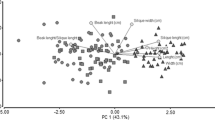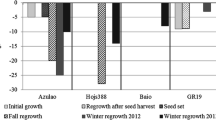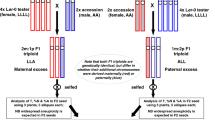Abstract
Spontaneous outcrossing of different malesterile rapeseed lines and transgenic hybrids with a population of a weedy species, Raphanus raphanistrum L., has led to the harvest of numerous seeds showing a size dimorphism. Flow cytometry analysis correlated with chromosome counts showed that all of the large seeds belonged to rapeseed, whereas the small seeds were a mixture of mostly interspecific triploid hybrids, with some trigenomic amphidiploids, diploid and haploid rapeseed plants. Significant differences were revealed between the rapeseed lines and transgenic hybrids in their ability to form interspecific hybrids with Raphanus raphanistrum under natural conditions. Resistance to the herbicide Basta was properly expressed in the triploid and amphidiploid hybrids. Low male fertility of the interspecific triploid hybrids was not correlated with seed set in the subsequent generation.
Similar content being viewed by others
References
Boudry P, Mörchen M, Saumitou-Laprade P, Vernet P, Van Dijk H (1993) The origin and evolution of weed beets:consequences for the breeding and release of herbicide-resistant transgenic sugar beets. Theor Appl Genet 87:471–478
Bryngelsson T, Gustafsson M, Gréen B, Lind C (1988) Uptake of host DNA by the parasitic fungus Plasmodiophora brassiceae. Physiol Mol Plant Pathol 33:163–171
Chèvre AM, Eber F, Baranger A, Kerlan MC, Festoc G, Vallée P, Renard M (1994) Interspecific gene flow as a component of risk assessment for transgenic Brassicas. In: Proc 9th ISHS Symp Brassicas. Acta Hortic (in press)
Crawley MJ, Hails RS, Rees M, Kohn D, Buxton J (1993) Ecology of transgenic oilseed rape in natural habitats. Nature 363:620–623
Dale PJ, Irwin JA Scheffler JA (1993) The experimental and commercial release of transgenic crop plants. Plant Breed 111:1–22
De Block M (1990) Factors influencing the tissue culture and the Agrobacterium tumefaciens-mediated transformation of hybrid aspen and poplar clones. Plant Physiol 93:1110–1116
De Block M, Botterman J, Vandewiele M, Dockx J, Thoen C, Gosséle V, Movva NR, Thompson C, Van Montagu M, Leemans J (1987) Engineering herbicide resistance in plants by expression of a detoxifying enzyme. EMBO J 6:2513–2518
De Block M, nDe Brouwer D, Tenning P (1989) Transformation of Brassica napus and Brassica oleracea using Agrobacterium tumefaciens and the expression of the bar and neo genes in the transgenic plants. Plant Physiol 91:694–701
De Greef W, Delon R, De Block M, Leemans J, Botterman J (1989) Evaluation of herbicide resistance in transgenic crops under field conditions. Biotechnology 7:61–64
Dröge-Laser W, Siemeling U, Pühler A, Broer I (1994) The metabolites of the herbicide L-phosphinothricin (glufosinate). Plant Physiol 105:159–166
Düring K (1994) A plant transformation vector with a minimal T-DNA. Transgenic Res 3:138–140
Eber F, Chèvre AM, Baranger A, Vallée P, Tanguy X, Renard M (1994) Spontaneous hybridization between a male-sterile oilseed rape and two weeds. Theor Appl Genet 88:362–368
Glimelius K, Fahlesson J, Landgren M, Sjödin C, Sundberg E (1991) Gene transfer via somatic hybridization in plants. Trends Biotechnol 9:24–30
Hu J, Quiros CF (1991) Identification of broccoli and cauliflower cultivars with RAPD markers. Plant Cell Rep 10:505–511
Jorgensen RB, Andersen B (1994) Spontaneous hybridization between oilseed rape (Brassica napus) and weedy Brassica campestris (Brassicaceae): a risk of growing genetically modified oilseed rape. Am J Bot 81:1620–1626
Kerlan MC, Chèvre AM, Eber F, Baranger A, Renard M (1992) Risk assessment of outcrossing of transgenic rapeseed to related species:I-Interspecific hybrid production under optimal conditions with emphasis on pollination and fertilization. Euphytica 62:145–153
Kerlan MC, Chèvre AM, Eber F (1993) Interspecific hybrids between a transgenic rapeseed (Brassica napus L.) and related species:cytogenetical characterization and detection of the transgene. Genome 36:1099–1106
Kessler DA, Taylor MR, Maryanski JH, Flamm EL, Kahl LS (1992) The safety of foods developed by biotechnology. Science 256:1747–1750
Lelivelt CLC, Krens FA (1992) Transfer of resistance to the beet cyst nematode (Heterodera schachtii Schm.) into the Brassica napus L. gene pool through intergeneric somatic hybridization with Raphanus sativus L. Theor Appl Genet 83: 887–894
Leterme P (1988) Croissance et développement du colza d'hiver:les principales étapes. In:Physiologie et élaboration du rendement du colza (in French). Cah Tech Cetiom, Cetiom (edn) pp 23–33
Mijushima U (1980) Genome analysis in Brassica and allied genera. In:Tsunoda F, Hinata K, Gomez-Campo C (eds) Brassica crops and wild allies, biology and breeding. Japan Sci Soc Press, Tokyo, pp 89–106
Pelletier G, Primard C, Vedel F, Chétrit P, Remy R, Rousselle P, Renard M (1983) Intergeneric cytoplasmic hybridization in Cruciferae by protoplast fusion. Mol Gen Genet 191:244–250
Prakash S, Hinata K (1980) Taxonomy, cytogenetics and origin of crop Brassicas, a review. Opera Bot 55:1–57
Prins TW, Zadocks JC (1994) Horizontal gene transfer in plants, a biohazard? Outcome of a literature review. Euphytica 76:133–138
Renard M, Dosba F (1980) Etude de l'haploidie chez le colza (Brassica napus L. var ‘oleifera’ Metzger) (in French) Ann Amélior Plant 30:191–209
Rosén B, Olin-Fatih M (1993) Raphanobrassica somatic hybrids between Brassica napus L. and Raphanus sativus L. with aneuploid, chimaeric chromosome numbers. Sver Utsaedesfoeren Tidskr 103:147–153
Sambrook J, Fritsch EF, Maniatis T (1989) Molecular cloning: a laboratory manual, 2nd edn. Cold Spring Harbor Laboratory Press, Cold Spring Harbor, N.Y.
Scheffler JA, Dale PJ (1994) Opportunities for gene transfer from transgenic oilseed rape (Brassica napus) to related species. Transgenic Res 3:263–278
Song K, Osborn TC, Williams PH(1988) Brassica taxonomy based on nuclear restriction fragment length polymorphisms (RFLPs). 1. Genome evolution of diploid and amphidiploid species. Theor Appl Genet 75:784–794
Takeshita M, Kato M, Tokumasu S (1980) Application of ovule culture to the production of intergeneric or interspecific hybrids in Brassica and Raphanus. Jpn J Genet 55:373–387
Thompson CJ, Movva NR, Tizard R, Crameri R, Davies JE, Lauwereys M, Butterman J (1987) Characterization of the herbicide resistance gene bar from Streptomyces hygroscopicus. EMBO J 6:2519–2523
UN (1935) Genomic analysis in Brassica with special reference to the experimental formation of Brassica napus and peculiar mode of fertilization. Jpn J Bot 7:389–452
Velten J, Schell J (1985) Selection-expression plasmid for use in genetic transformation of higher plants. Nucleic Acids Res 13:6981–6998
Warwick SI, Black LD (1991) Molecular systematics of Brassica and allied genera (Subtribe Brassicinae, Brassiceae)-chloroplast genome and cytodeme congruence. Theor Appl Genet 82:81–92
Yoder JI, Goldsbrough AP (1994) Transformation systems for generating marker-free transgenic plants. Biotechnology 12:263–267
Author information
Authors and Affiliations
Additional information
Communicated by Y. Gleba
Rights and permissions
About this article
Cite this article
Baranger, A., Chèvre, A.M., Eber, F. et al. Effect of oilseed rape genotype on the spontaneous hybridization rate with a weedy species:an assessment of transgene dispersal. Theoret. Appl. Genetics 91, 956–963 (1995). https://doi.org/10.1007/BF00223906
Received:
Accepted:
Issue Date:
DOI: https://doi.org/10.1007/BF00223906




